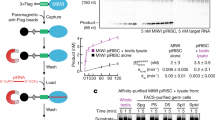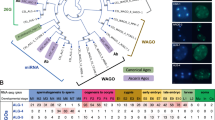Abstract
Small RNAs bound to Argonaute proteins recognize partially or fully complementary nucleic acid targets in diverse gene-silencing processes1,2,3,4. A subgroup of the Argonaute proteins—known as the ‘Piwi family’5—is required for germ- and stem-cell development in invertebrates6,7, and two Piwi members—MILI and MIWI—are essential for spermatogenesis in mouse8,9. Here we describe a new class of small RNAs that bind to MILI in mouse male germ cells, where they accumulate at the onset of meiosis. The sequences of the over 1,000 identified unique molecules share a strong preference for a 5′ uridine, but otherwise cannot be readily classified into sequence families. Genomic mapping of these small RNAs reveals a limited number of clusters, suggesting that these RNAs are processed from long primary transcripts. The small RNAs are 26–31 nucleotides (nt) in length—clearly distinct from the 21–23 nt of microRNAs (miRNAs) or short interfering RNAs (siRNAs)—and we refer to them as ‘Piwi-interacting RNAs’ or piRNAs. Orthologous human chromosomal regions also give rise to small RNAs with the characteristics of piRNAs, but the cloned sequences are distinct. The identification of this new class of small RNAs provides an important starting point to determine the molecular function of Piwi proteins in mammalian spermatogenesis.
This is a preview of subscription content, access via your institution
Access options
Subscribe to this journal
Receive 51 print issues and online access
$199.00 per year
only $3.90 per issue
Buy this article
- Purchase on Springer Link
- Instant access to full article PDF
Prices may be subject to local taxes which are calculated during checkout




Similar content being viewed by others
References
Meister, G. & Tuschl, T. Mechanisms of gene silencing by double-stranded RNA. Nature 431, 343–349 (2004)
Mello, C. C. & Conte, D. Jr. Revealing the world of RNA interference. Nature 431, 338–342 (2004)
Matzke, M. A. & Birchler, J. A. RNAi-mediated pathways in the nucleus. Nature Rev. Genet. 6, 24–35 (2005)
Zamore, P. D. & Haley, B. Ribo-gnome: the big world of small RNAs. Science 309, 1519–1524 (2005)
Carmell, M. A., Xuan, Z., Zhang, M. Q. & Hannon, G. J. The Argonaute family: tentacles that reach into RNAi, developmental control, stem cell maintenance, and tumorigenesis. Genes Dev. 16, 2733–2742 (2002)
Cox, D. N. et al. A novel class of evolutionarily conserved genes defined by piwi are essential for stem cell self-renewal. Genes Dev. 12, 3715–3727 (1998)
Reddien, P. W., Oviedo, N. J., Jennings, J. R., Jenkin, J. C. & Sanchez Alvarado, A. SMEDWI-2 is a PIWI-like protein that regulates planarian stem cells. Science 310, 1327–1330 (2005)
Kuramochi-Miyagawa, S. et al. Mili, a mammalian member of piwi family gene, is essential for spermatogenesis. Development 131, 839–849 (2004)
Deng, W. & Lin, H. miwi, a murine homolog of piwi, encodes a cytoplasmic protein essential for spermatogenesis. Dev. Cell 2, 819–830 (2002)
Aravin, A. A. et al. The small RNA profile during Drosophila melanogaster development. Dev. Cell 5, 337–350 (2003)
Bartel, D. P. MicroRNAs: genomics, biogenesis, mechanism, and function. Cell 116, 281–297 (2004)
Chen, P. Y. et al. The developmental miRNA profiles of zebrafish as determined by small RNA cloning. Genes Dev. 19, 1288–1293 (2005)
Bellve, A. R. et al. Spermatogenic cells of the prepuberal mouse. Isolation and morphological characterization. J. Cell Biol. 74, 68–85 (1977)
Siepel, A. et al. Evolutionarily conserved elements in vertebrate, insect, worm, and yeast genomes. Genome Res. 15, 1034–1050 (2005)
Mochizuki, K. & Gorovsky, M. A. Small RNAs in genome rearrangement in Tetrahymena. Curr. Opin. Genet. Dev. 14, 181–187 (2004)
Grewal, S. I. & Rice, J. C. Regulation of heterochromatin by histone methylation and small RNAs. Curr. Opin. Cell Biol. 16, 230–238 (2004)
Jenab, S. & Morris, P. L. Testicular leukemia inhibitory factor (LIF) and LIF receptor mediate phosphorylation of signal transducers and activators of transcription (STAT)-3 and STAT-1 and induce c-fos transcription and activator protein-1 activation in rat Sertoli but not germ cells. Endocrinology 139, 1883–1890 (1998)
Pfeffer, S. et al. Identification of microRNAs of the herpesvirus family. Nature Methods 2, 269–276 (2005)
Pfeffer, S., Lagos-Quintana, M. & Tuschl, T. in Current Protocols in Molecular Biology (eds Ausubel, F. M. et al.) 26.4.1–26.4.18 (John Wiley and Sons, New York, 2003)
Lagos-Quintana, M. et al. Identification of tissue-specific microRNAs from mouse. Curr. Biol. 12, 735–739 (2002)
Pfeffer, S. et al. Identification of virus-encoded microRNAs. Science 304, 734–736 (2004)
Lim, L. P., Glasner, M. E., Yekta, S., Burge, C. B. & Bartel, D. P. Vertebrate microRNA genes. Science 299, 1540 (2003)
Berezikov, E. et al. Phylogenetic shadowing and computational identification of human microRNA genes. Cell 120, 21–24 (2005)
Legendre, M., Lambert, A. & Gautheret, D. Profile-based detection of microRNA precursors in animal genomes. Bioinformatics 21, 841–845 (2005)
Pruitt, K. D., Tatusova, T. & Maglott, D. R. NCBI Reference Sequence (RefSeq): a curated non-redundant sequence database of genomes, transcripts and proteins. Nucleic Acids Res. 33, D501–D504 (2005)
Acknowledgements
We thank J. Brennecke, M. Landthaler, Y. Pei, K. Fejes Toth and A. Sewer for discussion and help with the manuscript. We also thank L. Mitchell and K. Hwang for expert assistance in germ-cell purification, M. Poy and M. Stoffel for providing mouse tissues, and D. Weir and R. Choksi for assistance with sequencing. This work was supported by a FRAXA Research Foundation postdoctoral fellowship to A.A., an NIH grant to P.M., NIH grants to T.T., and an SNF grant to M.Z. Author Contributions A.A., S.P. and M.L.-Q. prepared the mouse, and P.L. and N.I. the human, testes small RNA libraries. A.A. recognized the presence of piRNAs, performed the MILI IPs, prepared the MILI-interacting small RNA library, and performed, together with N.I., the northern blotting analysis. S.K.-M. and T.N. produced, characterized and purified the MILI antibody. T.T. developed the concept of cloning from Ago/Piwi IPs. P.M. isolated germline cells. M.C., J.J.R. and J.J. performed the large-scale sequencing. The bioinformatic analyses of piRNAs were designed and carried out by D.G. and M.Z. with input from A.A. and T.T. The database of RNAs with known function was compiled by M.Z., R.S., P.L. and S.P., the software used for small RNA annotation was developed by M.Z., R.S. and C.S., and the manuscript was written by A.A., M.Z. and T.T.
Author information
Authors and Affiliations
Corresponding authors
Ethics declarations
Competing interests
Sequences of the piRNAs determined in this paper are given in Supplementary Tables 4 and 9. Reprints and permissions information is available at npg.nature.com/reprintsandpermissions. The authors declare no competing financial interests.
Supplementary information
Supplementary Notes
This file contains Supplementary Methods, Supplementary Tables 1–10 (excluding 3, 4, 6–9) and their legends, and Supplementary Figure Legends. (DOC 168 kb)
Supplementary Table 3
Summary of the mouse piRNA clusters. (XLS 28 kb)
Supplementary Table 4
List of mouse piRNA clones. (XLS 1039 kb)
Supplementary Table 6
Mouse piRNA minicluster alignments. (DOC 270 kb)
Supplementary Table 7
Human piRNA minicluster alignments. (DOC 30 kb)
Supplementary Table 8
Summary of the human piRNA clusters. (XLS 21 kb)
Supplementary Table 9
Supplementary Table 9 nature04916-s7.xls List of human piRNA clones. (XLS 194 kb)
Supplementary Figures
This file contains Supplementary Figures 1–6. (PDF 5095 kb)
Rights and permissions
About this article
Cite this article
Aravin, A., Gaidatzis, D., Pfeffer, S. et al. A novel class of small RNAs bind to MILI protein in mouse testes. Nature 442, 203–207 (2006). https://doi.org/10.1038/nature04916
Received:
Accepted:
Published:
Issue Date:
DOI: https://doi.org/10.1038/nature04916
This article is cited by
-
PiRNA hsa_piR_019949 promotes chondrocyte anabolic metabolism by inhibiting the expression of lncRNA NEAT1
Journal of Orthopaedic Surgery and Research (2024)
-
The burgeoning importance of PIWI-interacting RNAs in cancer progression
Science China Life Sciences (2024)
-
Themes and variations on piRNA-guided transposon control
Mobile DNA (2023)
-
The emerging role of the piRNA/PIWI complex in respiratory tract diseases
Respiratory Research (2023)
-
The epigenetic regulatory mechanism of PIWI/piRNAs in human cancers
Molecular Cancer (2023)
Comments
By submitting a comment you agree to abide by our Terms and Community Guidelines. If you find something abusive or that does not comply with our terms or guidelines please flag it as inappropriate.



